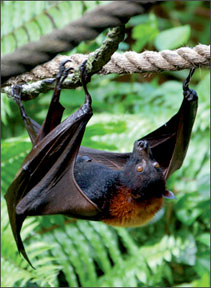‘Batmen’ from the animal kingdom
by K. G. H. Munidasa
A friend who had once observed a small bat taking a gecko in his
lighted verandah later asked me whether the bats after all fed on
anything other than insects and fruits.
|

Hides during the day, comes out at dusk |
He was fascinated to hear that while the food of the majority of them
was insects, certain bats prayed on small vertebrates like frogs,
lizards or birds, and one species, at least, to some extent on other
bats. But, when I told him that bats of the family MEGADERMATIDAE were
structurally adapted to subsist on blood, and found harmful to both man
and domestic animals, he was dumbfounded.
Two species of blood-sucking bats are known to occur in Sri Lanka.
The smaller of the two is common locally in the Low-Country Wet Zone and
the hills to about 3,000 feet elevations. The Lankan species Megaderma
spasma ceylonese is a uniformly bluish-grey bat measuring only 2.6
inches in length.
The other, the Indian species is larger, with a wingspan of 17
inches. It is said to be common in the Kalutara district and the suburbs
of Colombo, and has been recorded from Peradeniya, Gammaduwa, and also
Kumbalgamuwa, in the Hill Zone.
The vampire bats live in small colonies of 4-6 individuals, hiding
during the day in abandoned buildings, hollow trees, caves and old
plumbago mines, from where they come forth at dusk to fly about low over
the ground, looking for prey.
It is the Indian species Lyraderma lyra lyra, which often enters
houses after nightfall and picks geckos off the walls. It is also
described as a notorious robber of birds’ eggs and nestlings, and
devours even the roosting birds when these are caught unawares.
These blood-sucking bats are undoubtedly more destructive to the
small birdlife, as the following incidents of their predatory habits,
which I had detected forty years ago, should clearly show.
It was the month of December in the year 1969. The place was a small
planting settlement a couple of miles east of the Ampara town, on the
right bank of the Gal Oya river. With the collaboration of Bombay
Natural History Society, the Ceylon Bird Club was about to conduct its
3rd ringing operation on wagtails which, during that migratory season,
arrived in their thousands to roost in sugar cane patches, on the
periphery of the village.
On behalf of the CBC, I was keeping an eye on the birds until the
Club officials arrived with their paraphernalia to commence the ringing
operation.
Every evening I visited the roosting area to gather information and
made inquiries about the roosting pattern of the birds from the people
who lived in cottages around the place.
One evening, a servant boy of the Plantation Superintendent’s
quarters told me he used to clean the verandah of the remains of
numerous dead birds (wagtails), practically every morning. He had seen
only the bats flying about the verandah after dusk, and suspected the
culprits were bats.
A Government Surveyor, who was living still closer to the cane patch
endorsing the servant boy’s statement said he himself had discovered the
remains of 16 birds on his verandah one morning. With every victim the
head, bitten close, was left out with feathers strewn all around.
He confided this was a regular occurrence. One night a bird escaped
into his bedroom with a bleeding wound on its flank. He had seen the
predator, which according to his description was a bat, the size of a
pipistrelle.
In Sri Lanka the Indian Vampire is “occasionally accused of sucking
the blood of human beings, but no positive proof of this loathsome habit
has yet been found.” (Phillips).
But W. W. A. Phillips himself later quotes from a letter he had
received from a friend, which describes as follows, the experience of
two fellow-hunters who went on a weekend shoot near Telulla in the
Southern Province: “They took neither beds nor mosquito nets with them,
but slept in a cave, with their men in another, close by.
On the first morning Fisher woke up early, called the men and then
woke up Trail who stared at him in amazement and pointed out that his
(Fisher’s) pyjama coat was covered with blood.
He took it off and found big, red marks about the size of a rupee all
down his left side, with a little sort of puncture mark in the centre.
They did not irritate or worry him in any way and he felt perfectly fit.
In the evening they had all turned black and the marks remained for a
long time. The men said at once that the bats had made them” (Phillips’
Mammals of Ceylon - 1933)
In South America and Brazil, the commonest victims of the
blood-sucking vampires are horses, cattle and fowl, the latter quickly
dying from loss of blood as the result of a bite. Human beings, when
sleeping are sometimes the victims of these bats’ unpleasant attention.
The parts generally selected for the withdrawal of blood are the big
toes of the slumberers.
An old moth-eaten book on wildlife which I leafed through describes
the procedure as follows: “When about to feed, the vampires first of all
shave off a thin layer of their victims’ skin with the aid of their
razor-sharp incisor teeth. Thus the capillary blood vessels alone are
pierced and no pain is caused; the bats then suck up the blood that
gently oozes from the wounds.
When the creatures have finished their meal they seal up with their
saliva the punctures they have made, so that the blood ceases to flow.
Very often, however, some unconscious movement of the victim causes the
bat to fly away before it has had its fill and in which case the blood
would continue to flow from the wound a long time after.” |
